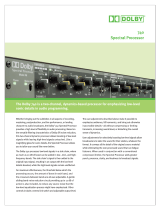Page is loading ...

Intended for use on soundstages and at optical transfer and
film QC facilities, the 737 reads the non-equalized outputs of a
cinema processor or mixing console. It can evaluate anything
from a trailer or commercial to elements of a feature’s complete
soundtrack for comparison purposes, and alerts mixers to the
potential for audience complaints about loudness levels when
the film is played in the cinema.
The 737’s operation is based on the measurement technique
known as Leq(m), developed by Dolby Laboratories after
extensive research into the perceived loudness of film
soundtracks. Unlike conventional audio meters such as VUs
and PPMs, the 737 monitors loudness over time—for the entire
length of a trailer, scene, or complete feature—and mimics the
varying sensitivity of the human ear at different frequencies,
taking particular note of those that are most annoying.
The 737’s measurement is displayed in decibels that can be
interpreted as an “annoyance factor” number. On material with
an occasional loud sound, the number will be relatively low,
while on material with loud sounds sustained over time the
number will be high.
In the 737, its six input channels are followed by weighting filters,
a true averaging power meter that can be started and stopped
remotely, and a trip circuit that indicates a preset maximum level
has been exceeded. In addition to showing measurement results
on its front panel display, the 737 can drive an external moving-
coil meter or chart recorder.
Use of the Dolby
®
737 meter has contributed to the adoption of
loudness standards for trailers and commercials in most areas
throughout the world, a reduction in the number of audience
complaints, and an improved moviegoing experience.
The Dolby 737 Soundtrack Loudness Meter monitors the subjective loudness of trailers
and other film soundtracks as they are being prepared.
737
Soundtrack Loudness Meter

Dolby Laboratories, Inc. 100 Potrero Avenue, San Francisco, CA 94103-4813 Telephone 415-558-0200 Fax 415-863-1373
Wootton Bassett, Wiltshire SN4 8QJ, England Telephone (44) 1793-842100 Fax (44) 1793-842101 www.dolby.com
Analog Audio Inputs
6 × 3-pin female XLR connectors, balanced:
L, C, R, Ls, Rs, SW
Sensitivity: –10 to +12 dBu
Impedance: 30 kΩ, 220 pF
Input Range: 72–95 dB-Leq(m)
Monitor Output
3-pin XLR male connector, unbalanced
Measurement mode: mono mix, weighted
by filters
Calibration mode: mono mix, unweighted
Impedance: 100Ω
Level: 0 dBu nominal, adjustable from
–20 to 0 dBu for Dolby level
Maximum level: +20 dBu
DC Output
3-pin XLR male connector, unbalanced,
for driving external meter or chart recorder
Operating range: 0–1.25 VDC; 0 VDC
corresponds to 70 Leq(m)
Output resistance: 1 kΩ
Power/Control
8-pin pluggable screw terminal connector
Trip indicator: open collector output; 100 mA
max to ground for tripped, 24 VDC max for
not tripped
Start/Stop command: open circuit for Start,
ground for Stop, maximum open circuit
leakage 100 µA; the unit sources 1 mA when
held low (Stop)
Power supply: 24 VAC, 500 mA
Push-Button Controls
Calibrate, Start, Stop
Leq(m) LED Display
Two-digit LED shows current
and final Leq(m) value
Trip LED
Indicates when preset maximum Leq(m)
value is exceeded
Trip Set
16-position, screwdriver-adjustment
for setting trip level
Calibration LEDs
For setting input levels
Input Trimpots
Six trimpots for input level calibration
Dolby 737 Soundtrack Loudness Meter
Measurement Accuracy
Weighting filter: (m)-weighting, ±0.5 dB,
30 Hz to 16 kHz
Measurement: ±0.25 dB, within the range
of 75–90 dB-Leq(m)
LED display: ±1 digit
Trip Indicator Range
78–92 dB-Leq(m), adjustable
Measurement Time
Maximum measurement length: 10 hours
Power Requirements
100 to 135 VAC using external power transformer
shipped with unit to 110 V countries, 200 to
240 VAC with transformer shipped to 230 V
countries, 10 W
Dimensions and Weight
44 × 483 × 267 mm (1.75 × 19 × 10.5 inches)
Net: 3.9 kg (8.5 lb)
Environmental Conditions
10° to 40°C (50° to 104°F); natural
convection cooling
90% maximum relative humidity (noncondensing)
Nonoperating (storage): 0° to 70°C (32° to 158°F)
Regulatory Notices
US: This unit complies with the limits for a
Class A digital device, pursuant to Part 15 of
the FCC Rules.
Europe: This product complies with the
requirements of Low Voltage Directive
73/23/EEC and EMC Directive 89/336/EEC
and carries the CE marking accordingly.
Warranty
One-year limited parts and labor; see disclaimer.
Specifications subject to change without notice.
Reference
Are Movies Too Loud? Ioan Allen, SMPTE Journal,
(March 22, 1997); also available at
www.dolby.com
Disclaimer of Warranties
Equipment manufactured by Dolby Laboratories is warranted against
defects in materials and workmanship for a period of one year from the
date of purchase. There are no other express or implied warranties and
no warranty of merchantability or fitness for a particular purpose, or of
noninfringement of third-party rights (including, but not limited to,
copyright and patent rights).
Limitation of Liability
It is understood and agreed that Dolby Laboratories’ liability, whether
in contract, in tort, under any warranty, in negligence, or otherwise
shall not exceed the cost of repair or replacement of the defective
components or accused infringing devices, and under no circumstances
shall Dolby Laboratories be liable for incidental, special, direct, indirect,
or consequential damages (including, but not limited to, damage to
software or recorded audio or visual material), cost of defense, or loss of
use, revenue, or profit, even if Dolby Laboratories or its agents have been
advised, orally or in writing, of the possibility of such damages.
Dolby and the double-D symbol are registered trademarks of
Dolby Laboratories.
© 2004 Dolby Laboratories, Inc. All rights reserved. S04/13662/15290
Dolby Part No. 91890, Issue 3
737 Front Panel
737 Rear Panel
/








